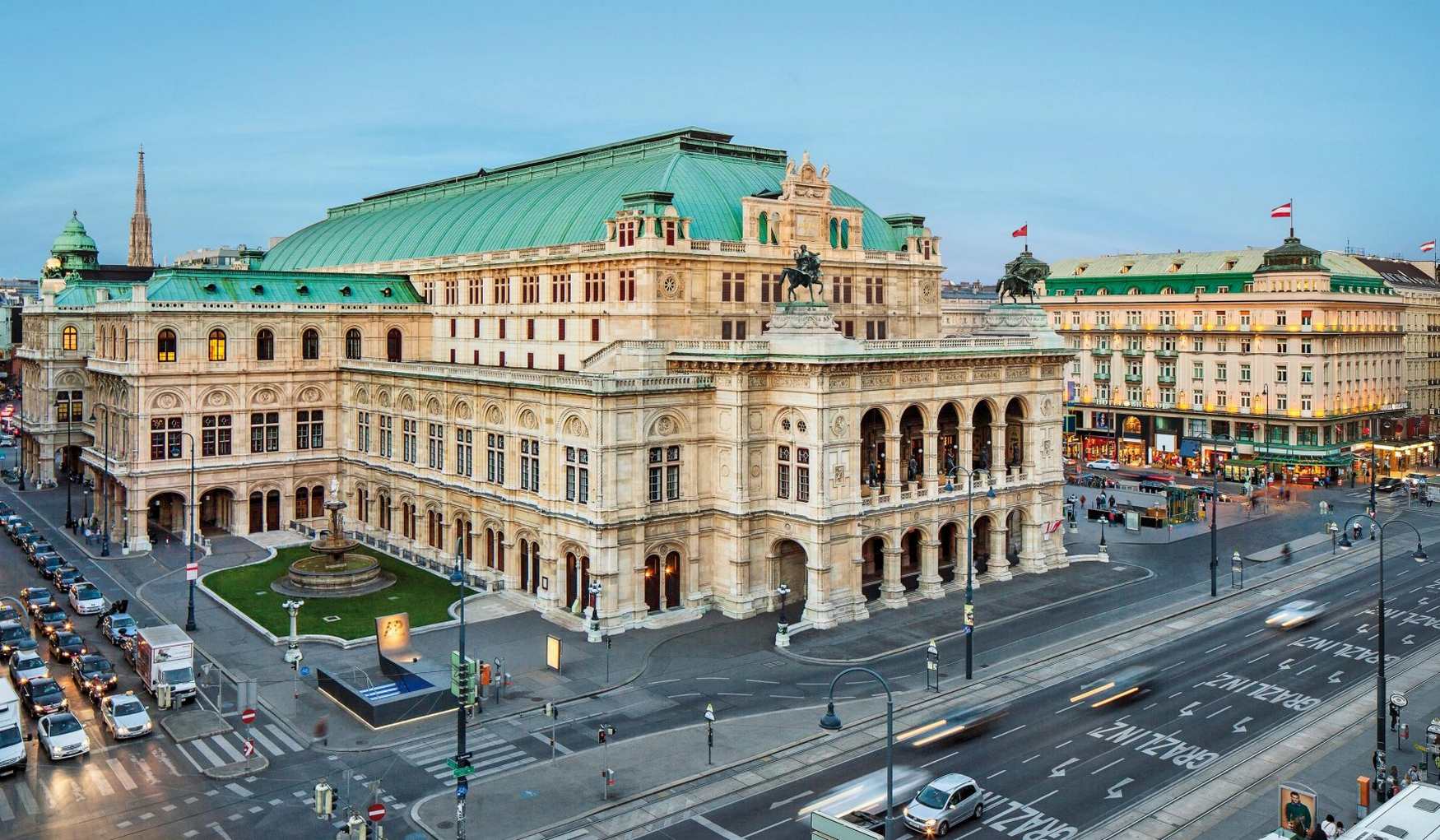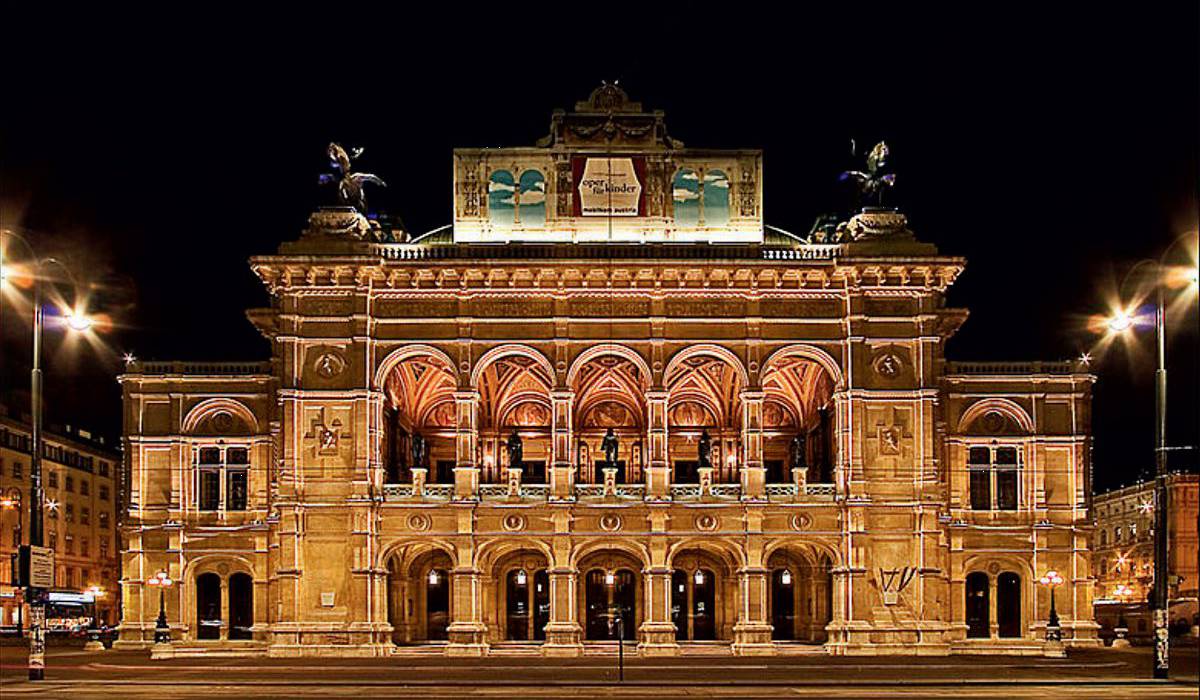"Vienna State Opera" — these words alone seem to capture the essence of Vienna, a city that is at once solemn, pompous and sublime. Do you have to be made of special material to visit one of Vienna's main attractions? Not at all: you can even dress casually for a performance at the Opera House, tickets (at affordable prices) can be bought online in advance, and there are special performances for children.
.jpg)
The history of the Vienna State Opera
The Court Opera first appeared in Vienna in the 17th century, but it was not until the second half of the 19th century that it acquired its own building. The building was designed by the architect August von Sicard Sickardsburg, and the interior was designed by Eduard van der Nüll.
On the opening day of the opera house, 25 May 1869, Mozart's opera Don Giovanni was performed. Emperor Franz Joseph I and Empress Elisabeth of Bavaria attended the performance.
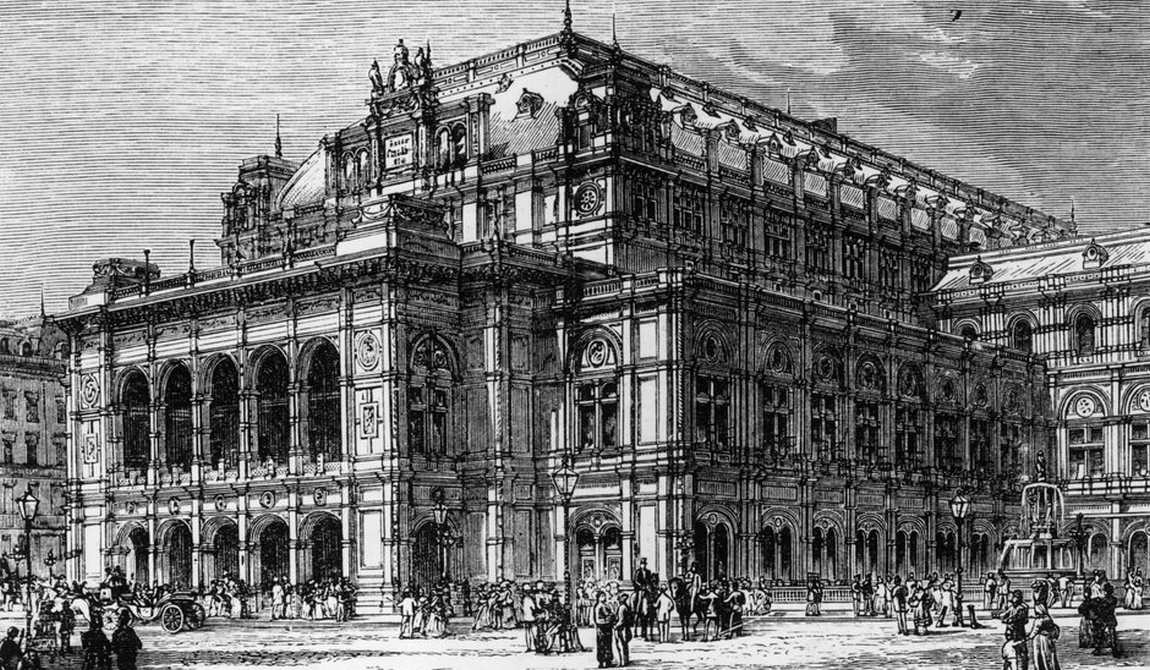
The first opera directors were the playwright and theatre director Franz von Dingelstedt, the composer and conductor Johannes Herbeck, the actor and theatre man Franz von Jauner and the conductor Wilhelm Jahn.
In 1897, the famous conductor and composer Gustav Mahler became director of the Vienna Opera. His tenure lasted 10 years and was considered one of the best years for the opera.
Mahler radically changed the approach to staging and, together with the artist Alfred Roller, developed a new aesthetic for the stage, recruited new conductors and enriched the repertoire (among other things, he staged Tchaikovsky's opera Eugene Onegin).
The worst moments in the history of the Vienna State Opera were the years of the Second World War. When the Nazis came to power, many of the theatre's artists were dismissed, arrested or murdered, and works by undesirable authors disappeared from the repertoire.
In March 1945, the theatre was destroyed in a bombing raid. Nevertheless, on 1 May 1945 the first production after the liberation of Vienna from the Nazis took place - the State Opera Company performed on the stage of the Volksoper Wien.
The Volksoper served as a temporary stage until 1955, when the beautiful building on the Ringstrasse was completed. Beethoven's opera Fidelio was performed at the opening of the renovated theatre on 5 November 1955.
The opening ceremony was televised, and the symbolism of the choice of work is easy to understand: the declaration of Austrian independence in May 1955 opened a new chapter in the history of the state.
In 2019, the Vienna State Opera celebrated its 150th anniversary with a production of Richard Strauss's opera Die Frau ohne Schatten. The famous composer and conductor was also the director of the Vienna State Opera, and his works have been performed there more than 3,000 times.
Architecture
It is a sad fact that neither the chief architect of the opera house, August von Sicard Sickardsburg, nor the interior designer, Eduard van der Null, lived to see the opening of the theatre. It is believed that the former suffered a heart attack and the latter committed suicide after being criticised by Franz Joseph I.

The emperor thought the Vienna State Opera building looked like a railway station, and the nobility were not happy: the entrance to the theatre was so narrow and the grand staircase so short that there was nowhere to show off the luxurious toilets.
But what was considered tasteless in the 19th century is now hailed as a fine example of Neo-Renaissance. Even those who do not intend to visit the theatre stop in front of it to admire the two pegasi above the main façade and the bronze statues in the arches of the first floor.
The Opera's main façade, the grand staircase and the three foyers, badly damaged in the bombing, have been restored to their original appearance. Inside, however, the Vienna Opera looked different - there was simply no money for a complete renovation in post-war Austria.
Restoration of the interior began in time for the centenary, and Franz Dobiachofsky's murals, some of which had been lost over time, have been restored to their former glory.
Repertoire
The repertoire of the Vienna State Opera is the largest in the world. Today it stages music by Rossini, Verdi, Mozart, Beethoven, Strauss, Wagner and other classics, as well as by contemporary composers.
A superficial knowledge of music is enough to appreciate the richness of the repertoire: the theatre has staged Richard Strauss's Salome, Puccini's Tosca, Rossini's Barber of Seville, Adan's Giselle, Massenet's Werther, Tchaikovsky's Eugene Onegin and Swan Lake, Mozart's Don Giovanni, Wagner's Der Ring des Nibelungen and other famous works.
You can look forward to Leo Delibes' ballet Sylvia, Jacques Offenbach's operas Les contes d'Hoffmann, Verdi's Troubadour, Donizetti's L'Amour, Benjamin Britten's A Midsummer Night's Dream, Handel's Ariodante and Berlioz' The Trojans.
The list of Viennese opera composers is completed by our contemporaries. In the year of the theatre's 150th anniversary, for example, Johannes Staud's The Willows and Manfred Trojan's Orestes were performed.
The Vienna Opera's programme is planned for the entire season and is published at the beginning of April. About a dozen premieres are staged each year, including both early and late works.
If you want to see a particular production, you have to hunt for it: every month 6-7 performances of the entire repertoire are staged and several concert programmes are prepared.
On the evening of 31 December, however, the same show appears on the programme of the Vienna State Opera: Johann Strauss's operetta Die Fledermaus is traditionally performed here before the New Year.
Opera’s stars
As internationally renowned as the Vienna State Opera and Ballet are, so too are the artists and conductors who perform on its stage, and the directors and choreographers who create its productions.
María Callas, Montserrat Caballé, Plácido Domingo, Luciano Pavarotti and Dmitri Hvorostovsky are among the greatest stars of the Vienna Opera.
The roster of soloists at the Vienna State Opera includes Dinara Alieva, Olga Bessmertnaya, Bryn Terfel, Juan Diego Flores, Thomas-Johanes Mayer and other outstanding opera singers. Maestro Domingo also sang and conducted in Vienna in the theatre's 2019 anniversary year.
In 2010, the Vienna Opera Ballet, Wiener Staatsballett, was founded under the direction of Manuel Legri. The company's repertoire includes Orff's Carmina Burana, Grieg's Per Gunt, Tchaikovsky's Onegin, Leo Delibe's Silvia, Le Corsaire (with the incomparable choreography of Marius Petipa) and Stravinsky's The Rite of Spring.
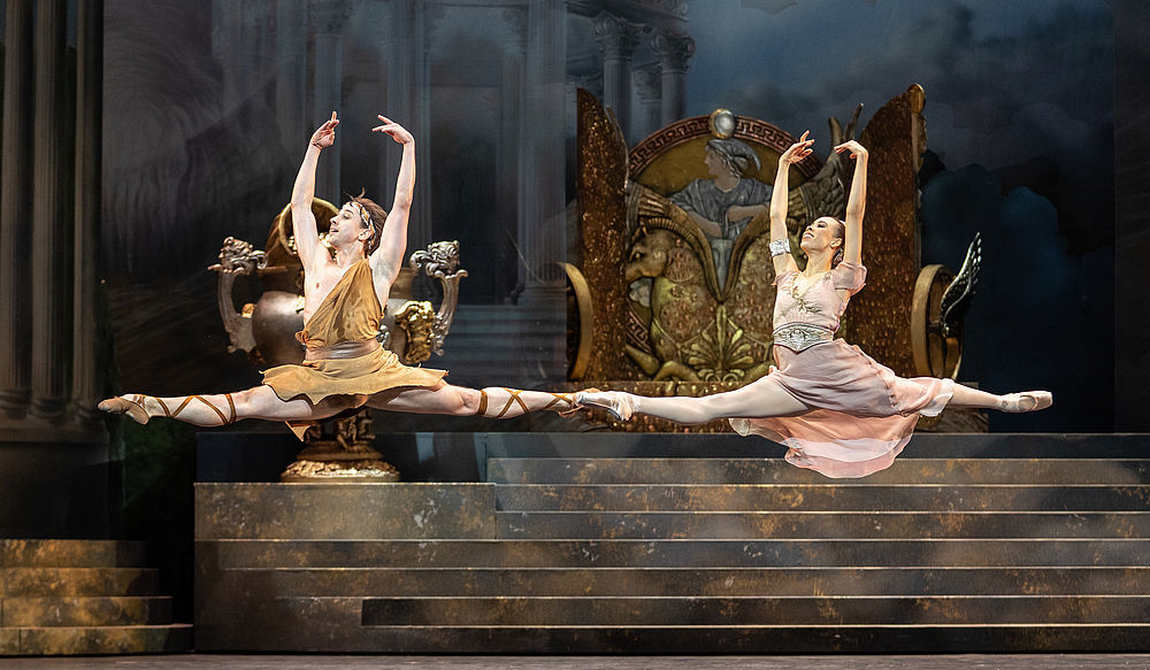
Every season the Nureyev Gala is held, featuring all the dancers of the Vienna State Ballet.
The main orchestra of the Vienna State Opera was conducted by Gustav Mahler, Richard Strauss, Herbert von Karajan, Otto Klemperer and Karl Böhm. Today the orchestra performs under the baton of Valery Gergiev, Myung Woon Chung, Semyon Bychkov, Mikhail Boder, Christian Thielemann and other leading conductors.
Not to mention the chorus, which gives 300 performances a year and performs 55 operas. There are now almost 100 singers in the Vienna Chorus.
Vienna Opera for kids
Children can be taken to any opera performance. Retell the libretto of Giuseppe Verdi's Aida, Mussorgsky's Boris Godunov, Strauss's Die Fledermaus or Tchaikovsky's Eugene Onegin in your own words and your child will be able to follow the plot.
The plot of Humperdinck's Hansel and Gretel is even easier to follow if your child knows the Grimm brothers' story.
Most importantly, the Opera House is home to the Vienna Children's Opera, which performs productions adapted for young audiences. Each season, the Vienna Opera presents a children's version of Mozart's Magic Flute, while the rest of the programme varies.
The children's repertoire includes Prokofiev's Symphonic Tale of Pét'a and the Wolf, Saint-Saëns' Suite Caraval de l'animal, Juan Arriaga's operas The Arabian Princess and Elisabeth Nasque's What Happened to Enaco? "Albert Lorzing's Ondina, Johanna Doderer's fairy tale opera Fatima or the Brave Children, Alma Deutscher's Cinderella and Ivan Erode's touching Button and Anton, based on the book by Erich Kaestner.
The beauty of these productions is that they feature children's dancers and a children's choir, and sometimes the audience is invited to sing along.
The Vienna Opera performances for children last one and a half hours. The recommended audience age is 6 years and older.
There are shows for children on the small stage. It is 80 metres from the main building.
Scheme of the Vienna State Opera
It is best to study the seating plan of the Vienna State Opera before purchasing tickets so that you can choose the right seats. Note the seats crossed out with an oblique line — this indicates a limited view.
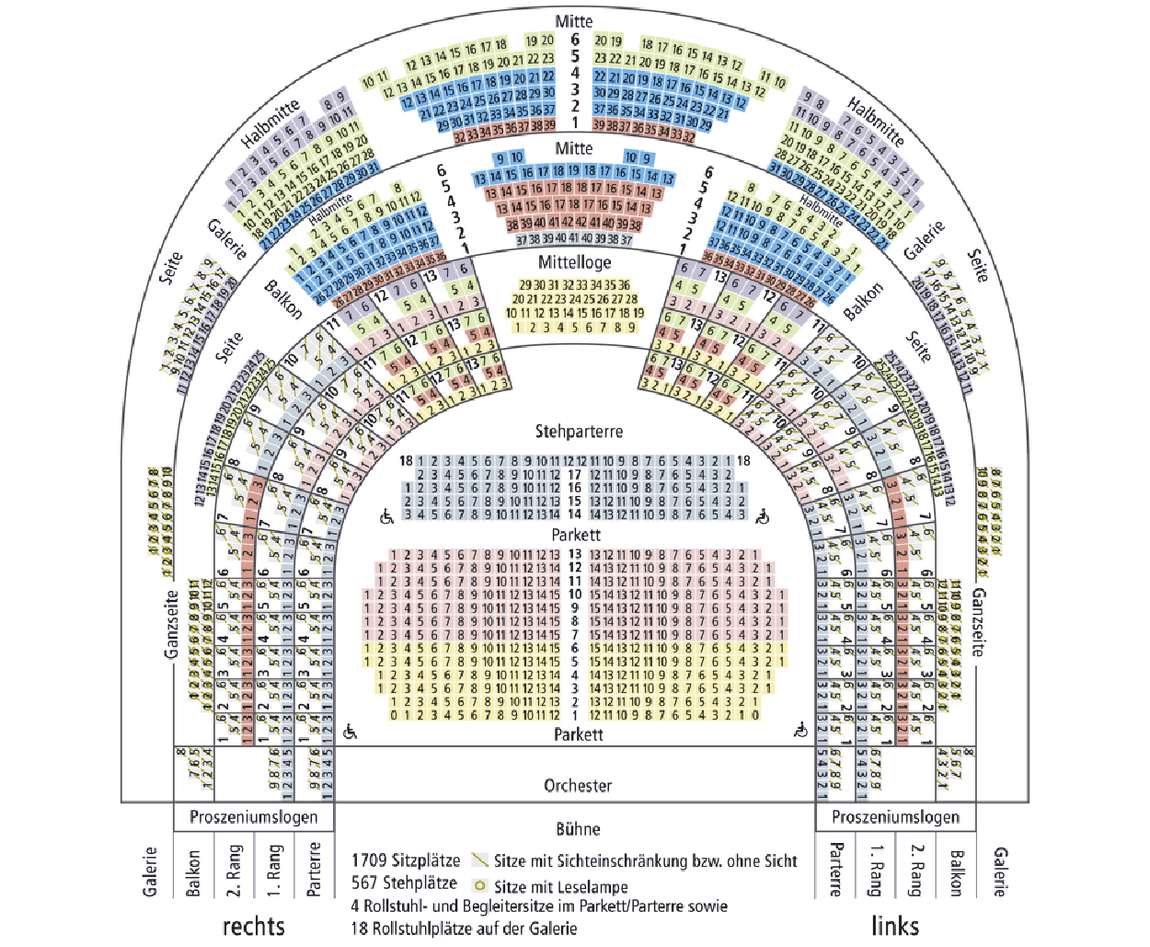
The theatre has 1709 seats and 567 standing places. All seats in the Vienna State Opera are equipped with monitors showing information about the performance. The monitors offer subtitles in several languages, including Russian, and you can order food from the buffet during the interval.
The price of tickets is also shown on the board. It depends on the category of seats and the category of the performance. The most expensive tickets for the best seats in the Vienna State Opera, in the stalls, cost around €290; the most modest tickets for seats cost around €20.
A standing room ticket costs from €12. There are special rates for wheelchair users at the Vienna State Opera. A child's ticket costs €15.
Ticket purchase
Ticket sales at the Vienna State Opera begin two months before the performance. However, the best guarantee of a seat at the Vienna State Opera is to book well in advance.
Reservations generally begin in April, when the programme for the coming season is published. Reservations can be made by telephone, e-mail or via the theatre's website.
Non-reserved tickets go on sale two months before the performance. There are two exceptions: tickets for September can only be purchased in May and tickets for October can only be purchased in June.
The ticket offices at Operngasse 2, Währinger Strasse 78 and Universitätsring 2 are open Monday to Friday from 8 a.m. to 6 p.m., on weekends and public holidays from 9 a.m. to 12 p.m. and on Sundays in December from 9 a.m. to 5 p.m. The evening box office in the foyer opens one hour before the performance.
Cheap tickets are only available at the Vienna State Opera box office if they are available on opening night and are not for a premiere or a star-studded production.
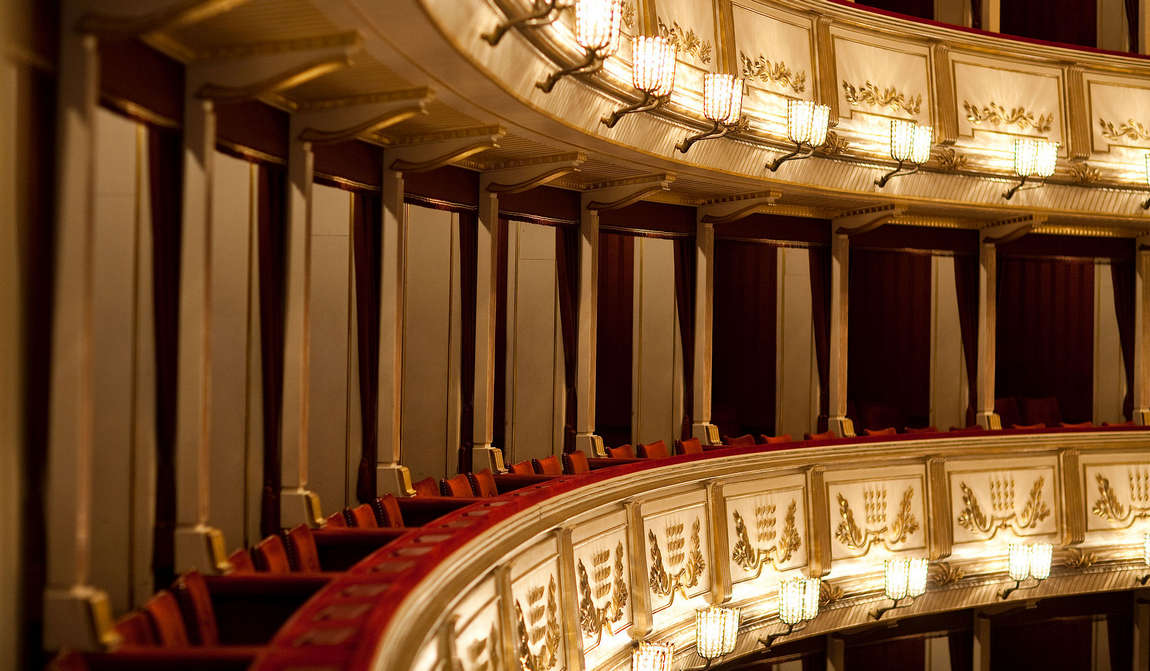 The easiest way to buy tickets for the Vienna State Opera is online. All you need to do is register on the website and enter your e-mail address and payment card details. The steps are very simple:
The easiest way to buy tickets for the Vienna State Opera is online. All you need to do is register on the website and enter your e-mail address and payment card details. The steps are very simple:
1. Select the performance you are interested in and click on "Buy Ticket". You will be informed of availability and prices.
2. If seats are available, you will see a map of the Vienna State Opera. Mark the seats that suit you and select whether you want an adult ticket (Normalpreiskarte) or a child ticket (Kinderkarte) from the drop-down list. Selected seats will be marked with a tick in the diagram.
3. Once you have made your selection, go to your shopping basket and register as a new user.
4. Enter your payment card details. Once you have completed this form, your card will be charged for the tickets you have ordered.
5. Once payment has been made, you will receive a notification and the tickets will be sent to the email address you provided during registration.
6. Print the e-tickets and exchange them for regular tickets at the Vienna Opera House before your visit. The exchange will take place at the box office at Operngasse 2.
7. Electronic tickets with a barcode do not need to be exchanged and will allow you direct access to the auditorium.
You can go to the ticket office even if you do not have your printed tickets with you. All you have to do is give your name and you will be issued with tickets.
However, buying Vienna State Opera tickets online is no easier than buying them at the box office. Cheap seats sell out in a flash, and expensive tickets for productions with celebrities disappear from the market very quickly.
Tickets for children
Children under 14 can visit the Vienna State Opera for just €15. Other prices apply only for premieres, on 31 December and for some season tickets.
Purchasing Vienna State Opera tickets online for a child is not much different from purchasing an adult ticket, but please note that you will need the child's passport and photo to exchange the e-ticket for a regular ticket at the box office.
It is advisable to go to the box office with the child, otherwise the child's ticket will not be issued. The deadline for exchanging tickets is 20 minutes before the start of the performance.
What to do if all the tickets are sold out
Even if you've taken the trouble to buy tickets in advance for the Vienna State Opera, it's not certain that you'll get them, especially if you want to see a performance with a star. However, you still have the chance to see the performance.
Firstly, you can put your name on a waiting list on the theatre's website. In the ticket purchase form, select the option "Order Tickets on Wartelist" and indicate the time you are willing to wait for a free ticket. If seats become available, you will be notified by email.
Second, standing room tickets will go on sale 80 minutes prior to curtain-up at the box office at Operngasse 2. Those who know how to get into the Vienna State Opera on a budget will be queuing up several hours before the performance.
In addition to the financial advantage of such a purchase, there is another secret: from the standing room of the Vienna State Opera, the stage is much more visible than from some of the balcony and gallery seats. There are even seats in the stalls.
Thirdly, during the months of April, May, June, September and over Christmas and New Year, it is possible to attend a performance of the Vienna State Opera for free: large screens have been set up in the open air to show live broadcasts of the opera.
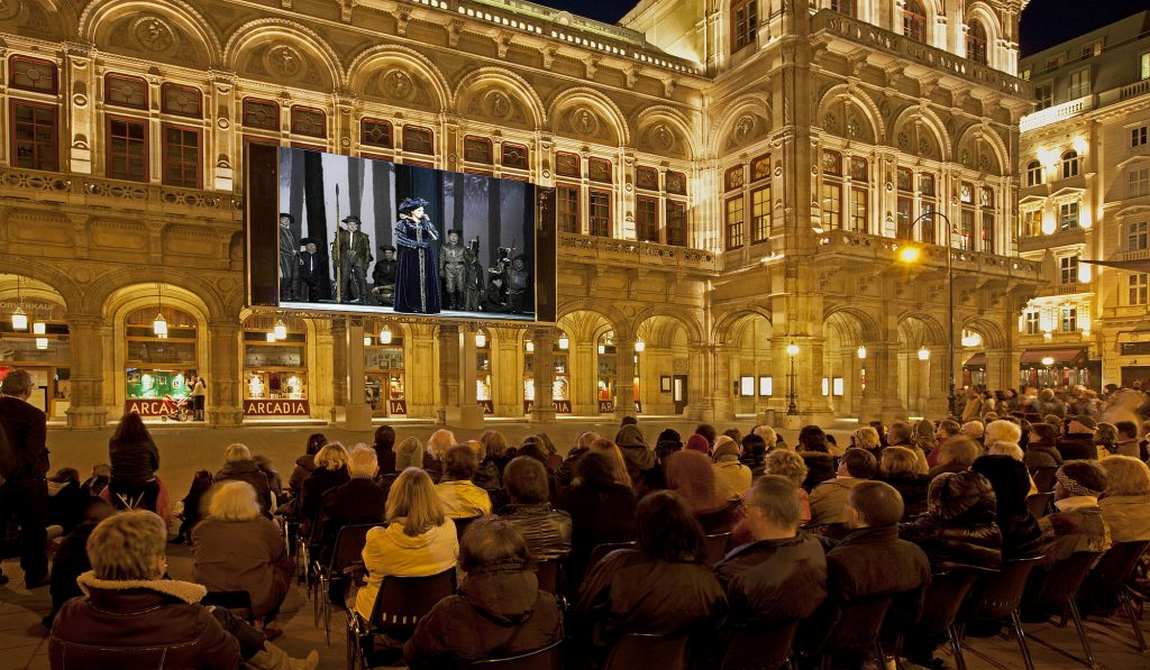
There are several hundred chairs in front of the theatre for the convenience of the audience, but many do not mind standing to listen to the opera or watch the ballet performed by the best dancers. It also has the advantage that you don't have to worry about what to wear when you go to the Vienna State Opera.
And fourth, it is possible to watch live broadcasts of Vienna State Opera performances on the Internet. Every year, 45 productions are broadcast and can be viewed within 72 hours of the performance.
Dress code
Strange as it may seem, there is no dress code at the Vienna State Opera. It's perfectly safe to come in casual clothes and not break the dress code.
If you're going to the opera in the colder months of the year, bring a pair of elegant shoes to change into in the cloakroom. Obviously, beachwear or dirty clothes are not acceptable in the theatre.
Of course, many people try to wear evening dress to emphasise the solemnity of the occasion. Evening dresses and tuxedos are also appropriate, but the choice of what to wear to the Vienna State Opera is up to you.
If you plan to attend the Viennese Ball, that is a different matter. There is a strict dress code for the Vienna State Opera: evening gowns for women and black tuxedos for men.
For ball debutantes, girls and young adults between the ages of 17 and 24, the dress code is even stricter. Girls wear snow-white ball gowns down to the floor, white gloves to the elbows, their hair pulled up and a tiara on their head. Young men wear black tails with white waistcoats, white gloves and a white bow tie.
It is even stipulated that young ladies must not wear necklaces and young men must not wear wristwatches (pocket watches are acceptable). Debutantes are also not allowed to have synthetic hair color, visible tattoos or piercings.
Tours
Where else would the phrase 'architecture is frozen music' sound as convincing as it does at the Vienna State Opera? The fact that the building has been rebuilt has not affected its appearance: the renovation was based on old drawings and photographs of the Vienna State Opera.
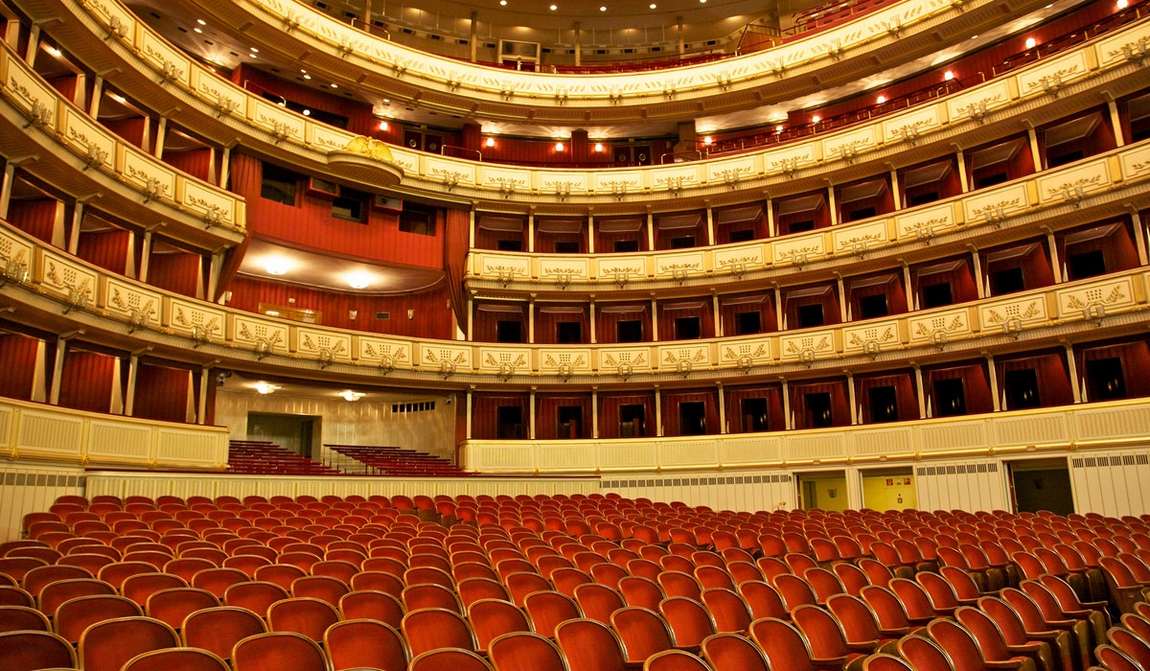
The theatre's interiors are so sumptuous that audiences take their time in the auditorium to admire the decorations in the foyer.
To see all the most beautiful rooms in the theatre, you can sign up for a 40-minute guided tour. The tour is available in several languages, including English, German and Russian (Russian must be booked in advance by telephone).
The tour begins in the foyer. You will then go up the grand staircase and see the Tea Room and the Gustav Mahler Hall before entering the auditorium of the Vienna State Opera.
The Tea Room can only be seen as part of a guided tour (normal visitors only see the curtained windows). This was once the foyer of the Imperial Box, from where Emperor Franz Joseph I liked to watch the audience as they climbed the stairs.
The internal layout of the Opera House was slightly altered during the restoration of the building. Mahler's Hall was installed where the director's study used to be. The walls are decorated with drawings of famous opera scenes.
The stage has also been extensively modernised. On the tour you will learn about the structure of the stage, the technical innovations and how the sets and lighting are created.
Outside the opera house, there is also something to see. The fire curtain, which separates the backstage area from the auditorium, changes its appearance every year and becomes a canvas for contemporary artists.
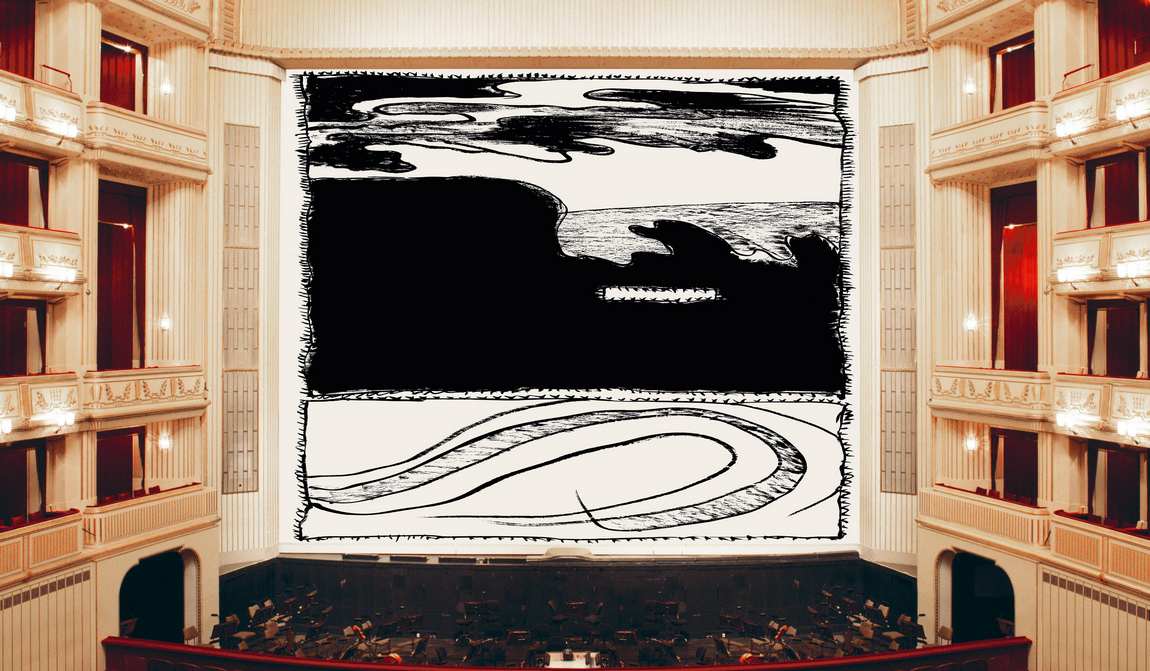
The curtain has been designed at various times by Cara Walker, Matthew Barney, Jeff Koons and Pierre Alechinsky. The actual work is shown before and after the performance and during the interval.
Some of the premises of the Vienna State Opera - the Schwindt Foyer, the Gustav Mahler Hall, the Marble Hall and the Tea Room - can be rented for events.
The Vienna State Opera Museum used to be part of the theatre, but was moved to the Theatre Museum in 2014.
It is very close to the Opera House and definitely deserves to be on the list of family excursions in Vienna. Its most impressive exhibits are theatrical costumes and the replica of the theatre, which gives a glimpse of the stage and backstage area.
Interesting facts about Vienna State Opera
What else can visitors to the Vienna State Opera be interested in besides music? Here are some of the curiosities that the tour tells you about.
1. Gustav Mahler was first invited to be the third conductor at the Vienna State Opera. He had to work for the first two for a month, conducting almost every evening. Nevertheless, Mahler managed to produce a fresh production during this time.
2. Mahler's other revolutionary decisions as director included starting performances on time and banning latecomers from the hall. The impossibility of entering the hall once the performance had begun angered the Viennese, who saw this as a violation of tradition, but the director was adamant: what he called the tradition of being late was simply laxity.
3. If we put the figures for contemporary opera into context, we get the following picture:
- There are 350 performances per season, including eight or nine premieres;
- 600,000 people attend performances every year;
- There are 60 operas and ballets from the 17th to the 21st century;
- The opera company employs 30 conductors, 220 singers, 100 ballet dancers and a further 600 people in other professions;
- The Viennese Opera Ballet is opened by 150 debutants, and every year more than 5,000 people attend the ball;
- There are over 2,000 screens in the auditorium with subtitles in several languages, including Russian.
- The Vienna State Opera has an organ with 2,500 pipes. It is the only theatre in the world with such a powerful concert organ.
4. Vienna has three opera houses — the Vienna State Opera, the Volksoper and the Theater an der Wien. Around 10,000 tickets are sold out every night for one of their performances.
5. Two-thirds of visitors to the Vienna Opera are Austrians, and only one-third are foreigners.
6. Several musicians and singers from the Opera have formed the band Angizia, which plays avant-garde metal and gothic rock.
Useful tips
And now for a quick overview of how to get to the Vienna State Opera:
- book your tickets online as early as April if you want to see a star-studded cast on stage;
- buy your tickets two months in advance if you want a regular performance (which in Vienna means glitz and glamour);
- arrive at the theatre a few hours before the performance to buy standing room tickets;
- do not buy tickets by hand: street vendors at the entrance to the opera house may sell fake tickets;
- arrive on time — the theatre opens one hour before the performance and Gustav Mahler's ban on late arrivals still applies;
- enjoy a free live broadcast of the performance if you're unlucky enough to be in the audience.


